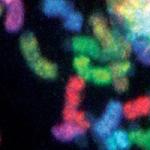
Paul Wade, Ph.D.
Senior Investigator
Epigenetics & Stem Cell Biology Laboratory / Eukaryotic Transcriptional Regulation Group
NIEHS
Research Topics
DNA function is strongly influenced by the nucleoprotein structures of chromosomes. These organelles harbor the genetic code in the linear sequence of bases of the DNA polymer. Superimposed on DNA sequence is additional information contained in patterns of chemical modification and nucleoprotein architecture that constitute epigenetic information. This information is instructive to the enzymes dedicated to nuclear DNA physiology. A major ongoing challenge is to decipher the properties of epigenetic information. Knowledge gaps exist in the information content of the epigenome, the mechanisms utilized by cells to copy this information during cell division, and the identity and regulation of the machinery responsible for 'reading' the code. These issues are complicated by the biological certainty that, unlike the genetic code, the epigenetic code must be dynamic within an individual organism.
Chromatin Remodeling
The long-term goals of my laboratory are to understand gene regulation within the context of eukaryotic chromatin (popularly termed epigenetics), and to relate gene regulatory events (and the factors involved) to biological events in the cell. One approach we have taken is to study in detail a single chromatin regulator in order to derive general principles that may apply to the larger family of such factors. For the past decade we have focused on the Mi-2/NuRD complex, a nuclear enzyme generally believed to function in the process of transcriptional repression. This complex has two independent enzymatic activities (chromatin remodeling ATPase and histone deacetylation) that are presumed integral to its biological functions. We study gene regulatory events mediated by Mi-2/NuRD using diverse biological model systems including breast cancer and B lymphocyte development and differentiation. We wish to address the following basic questions:
- What is the genomic distribution of Mi-2/NuRD complex and how is this controlled?
- What genes are regulated by Mi-2/NuRD complex - directly and indirectly?
- What mechanisms are utilized by Mi-2/NuRD complex to modulate gene activity?
- How does Mi-2/NuRD complex action influence biological properties of the relevant cell?
We are currently combining biochemical experiments with purified Mi-2/NuRD components with genomic experiments to study localization and function.
Epigenetic regulation and metabolism
As a complement to our studies on chromatin remodeling, we have implemented an animal model of diet-induced obesity to study how genes are regulated by environmental factors such as diet. We study colon epithelial cells and their interaction with diet and the gut microbiome. We find that obesity and its accompanying microbiome correlate with alterations in the transcriptome and with changes in histone modification, DNA methylation and transcription factor occupancy at enhancers. Systems level analysis demonstrates enrichment at loci associated with colon cancer and with metabolism. Our results collectively suggest an association between metabolic state of colon epithelial cells, gene regulation by chromatin and colorectal cancer risk. Future experiments will probe this relationship at a mechanistic level.
Transcription Factor function in chromatin
Packaging of DNA by chromatin represents a physical barrier for proteins that require access to DNA sequence, such as transcription factors. Some transcription factors, termed ‘pioneer transcription factors’, have the ability to recognize and bind their cognate recognition motifs even when packaged into chromatin. We study a pioneer transcription factor, GATA3, in the context of breast cancer. We find that GATA3 can bind to chromatin and induce formation of an enhancer site that activates nearby genes. Mutational analysis of GATA3 revealed that pioneer activity required an activation domain and correlated with ability to recruit chromatin remodeling proteins. Current studies in the lab are dissecting the mechanisms of how local chromatin architecture influences the outcome of transcription factor/DNA interactions using this model system.
Biography
Dr. Wade obtained his Ph.D. degree from Indiana University and completed postdoctoral training with Alan Wolffe at NICHD. After 4 years as an Assistant Professor in the Department of Pathology and Laboratory Medicine, Emory University School of Medicine, he moved to the NIH in 2004. Dr. Wade is currently a Senior Investigator and Deputy Chief in the Epigenetics and Stem Cell Biology Laboratory where he heads the Eukaryotic Transcriptional Regulation Group.
Selected Publications
- Fujita N, Jaye DL, Kajita M, Geigerman C, Moreno CS, Wade PA. MTA3, a Mi-2/NuRD complex subunit, regulates an invasive growth pathway in breast cancer. Cell. 2003;113(2):207-19.
- Fujita N, Jaye DL, Geigerman C, Akyildiz A, Mooney MR, Boss JM, Wade PA. MTA3 and the Mi-2/NuRD complex regulate cell fate during B lymphocyte differentiation. Cell. 2004;119(1):75-86.
- Li R, Grimm SA, Chrysovergis K, Kosak J, Wang X, Du Y, Burkholder A, Janardhan K, Mav D, Shah R, Eling TE, Wade PA. Obesity, rather than diet, drives epigenomic alterations in colonic epithelium resembling cancer progression. Cell Metab. 2014;19(4):702-11.
- Takaku M, Grimm SA, Roberts JD, Chrysovergis K, Bennett BD, Myers P, Perera L, Tucker CJ, Perou CM, Wade PA. GATA3 zinc finger 2 mutations reprogram the breast cancer transcriptional network. Nat Commun. 2018;9(1):1059.
- Grimm SA, Shimbo T, Takaku M, Thomas JW, Auerbach S, Bennett BD, Bucher JR, Burkholder AB, Day F, Du Y, Duncan CG, French JE, Foley JF, Li J, Merrick BA, Tice RR, Wang T, Xu X, NISC Comparative Sequencing Program., Bushel PR, Fargo DC, Mullikin JC, Wade PA. DNA methylation in mice is influenced by genetics as well as sex and life experience. Nat Commun. 2019;10(1):305.
Related Scientific Focus Areas





Molecular Biology and Biochemistry
View additional Principal Investigators in Molecular Biology and Biochemistry
This page was last updated on Friday, June 15, 2018